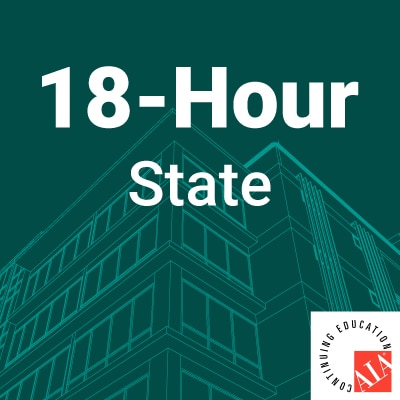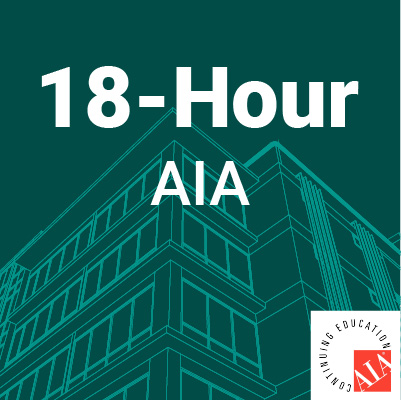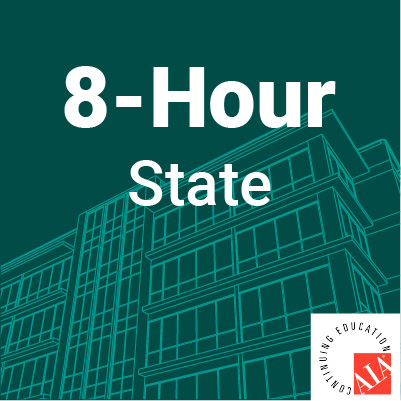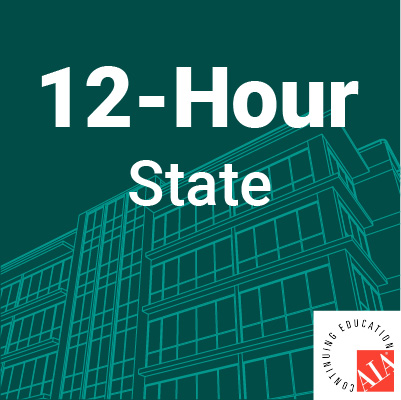Description
New York Complete 18Hour Continuing Education Course Package
Meets state continuing education requirements
This 18-hour package contains:
Course #1 – (5 HSW hour Audio Course) Moving Toward Net Zero | #AIABLTI518
Course #2 – (4 HSW hour Audio Course) Designing Worship Facilities | #AIABLTI515.22
Course #3 – (3 HSW hour Audio Course) Successful Code Analysis: Occupancy Group B | #AIABLTI458.22
Course #4 – (2 HSW hour Audio Course) Speaking of Older Buildings | #AIABLTI517
Course #5 – (2 HSW hour Audio Course) ADA Paths – Part 2 Practical Design Requirements | #AIABLTI512.23
Course #6 – (2 HSW hour Audio Course) ADA Paths – Part 3 Communication and Recreation | #AIABLTI513.23
Credit(s) earned on completion of this course will be reported to AIA CES for AIA members. Certificates of Completion for both AIA members and non-AIA members will be available to print upon completion of this course. This course is registered with AIA CES for continuing professional education.
Moving Toward Net Zero
Course Instructor: Paul Spite
Sustainability is defined by one source as “meeting current needs, without compromising the ability of future generations to meet their needs, in the environment we will leave them.” Net zero refers to achieving an overall balance between carbon-based emissions produced and the removal or offsetting of the same amount of carbon from the atmosphere. Taken together, striving to meet these two objectives can result in choices made in project design and project use, resulting in the least harm possible being done to our environment.
We will examine a few key principles involved in moving toward ‘net zero:
- Designing buildings that use as little energy as possible, once occupied as intended
- Generating as much power on-site, or the equivalent thereof, to supply the power still needed and used by the facility
- Look at carbon emissions and ways to lower or offset greenhouse gas emissions as a result of our activities
This course teaches the following knowledge and skills:
- An understanding of what is being referred to, when ‘net zero’ is being discussed
- An overview of broad strategies used in designing sustainable buildings
- Identifying sources of more environmentally friendly materials for incorporation in projects
- Why buildings renovated for adaptive reuse are arguably the greenest buildings.
- How incorporating passive design principles can reduce future energy use.
- Use of the earth’s temperature below the frost line to preheat and precool incoming air
- A good understanding of different options for insulating building envelopes
- How LEED certification can be sought and obtained
- Different ways in which green power can be purchased
- Criteria that can be used in purchasing Renewable Energy Certificates
- The various technologies used to generate power on site from renewable resources
- Steps to be taken in planning for an on-site renewable generation project
- The primary differences between renewable energy certificates and carbon offsets
- How clean water state revolving funds are used to finance conservation projects
This Course Covers:
Overall Steps in Reaching Net Zero
Part One – Minimizing Energy Use in Buildings
- Broad Design Concepts for Energy Conservation
- Energy Audits
- Passive Site and Building Design
- Designing for LEED Certification
- Recycling Buildings
- Energy Efficient Building Envelopes
- Energy Efficient Building Components
- Lifestyle Choices to Conserve Energy and Other Resources
- Creating Replacement Power
- Summary of Minimizing Energy Use
Part Two – Minimizing Carbon Output
- Purchasing Green Power
- Purchasing Carbon Offsets
- Funding Land Conservation Projects with the Clean Water State Revolving Fund
- Summary of Reducing Carbon Output
Designing Worship Facilities
Instructor: Paul Spite
Many decisions need to be made when undertaking the design of a facility to be used for worship. Some are esoteric, dealing with considerations on how to design the structure to best approach God. But others are more mundane, concerned with the fact that before the building may be occupied, the designer must first please men. This course will deal with the second.
Satisfying the needs of people involved in the project will involve those both inside and outside of the client group. Unless societal guidelines, like codes, zoning restrictions and existing easements are honored, regulatory agencies can make sure the building process doesn’t begin. Lending agencies will impose restrictions that must be honored. Site conditions will result in sometimes inflexible conditions on how the land may be used. The needs of the building community that will be translating construction documents into a physical reality must be addressed, as well as the way that process will come to fruition. Finally, every member of the religious group called the client will be bringing their own ideas to the table regarding the desired end result.
This course is designed to look at the many, sometimes seemingly endless parameters and decisions that must be made and addressed, before and during the design of a worship facility.
This course teaches the following specific knowledge and skills.
- A thorough understanding of the types of parameters that must be satisfied in the design of worship facilities
- An increased awareness of the various functions usually needing accommodated in worship facilities
- Knowledge of basic options available to religious groups facing the need to change or expand their facilities to accommodate growth
- How to guide religious groups in acknowledging the many costs besides the building, involved in completing projects, considering sources for capital and determining their financial feasibility of proceeding
- Educating clients regarding various players who will be involved in making their dream a reality and how to go about selecting them
- Different societal guidelines that act as parameters to be met while designing worship facilities
- Master planning considerations that should be incorporated in sites, buildings, systems and furnishings for religious clients
- Basic acoustic considerations to be addressed while designing the primary spaces of buildings used for assembly purposes
- Practical considerations and rules of thumb that help with initial layouts and schematic design of worship facilities
- Typical areas of concern found in building code restrictions, tending to govern the design of worship facilities.
This course covers:
- Introduction
- Options for Growth
- Counting the Costs
- Potential Sources of Capital
- Players in the Process
- Master Planning
- Acoustics in Worship
- Practical Concerns / Rules of Thumb
- Materials and Choices
- Rules and Regulations
- Building Codes Pertinent to Worship Facilities
- Conclusion
Successful Code Analysis: Occupancy Group B
Instructor: Wayde Hoppe
Most colleges spend very little time giving instruction to designers on how to comply with the building code. This may be because there used to be so many different types of building codes that it was impractical to offer instruction on every one of them. However, our country is moving closer to a nationwide standard. As we do, it is useful to know the basics on how to navigate your way through the building code. In this lesson we will look at the steps necessary to review a project against the building code, specifically looking at chapters 3, 5, 6, 7, and 9.
These chapters will allow us to identify the building use, the building construction type, the requirements for sprinkling, the requirements for frontage on clear area around the building, the height of the building and whether the building will be protected or not. We will review the requirements of chapters 3, 5, 6, 7 and 9 and we will discuss what options are available for a designer in his attempt to bring the desires of his client together with the limitations of the code. In order to get a clear understanding of this process, we will examine several sample projects. Our projects will all be a business use group. We will cover generic material about the building code and we will explore a specific use group and how the code applies to it.
After completing this course, you will be able to:
- Specify and identify the building use, the building construction type, the requirements for sprinkling, frontage on clear area around the building, the height of the building and whether the building will be protected or not.
- Understand and be able to comply with a specific use group and how the code applies to it.
- Be able to integrate design concepts with current codes and regulations.
- Translate the goals of the customer into a safe and cost-effective project that accounts for the limitations of the code.
Credit(s) earned on completion of this course will be reported to AIA CES for AIA members. Certificates of Completion for both AIA members and non-AIA members are available to print upon completion of the course.
This course is registered with AIA CES for continuing professional education. As such, it does not include content that may be deemed or construed to be an approval or endorsement by the AIA or any material of construction or any method or manner of handling, using, distributing, or dealing in any material or product.
Speaking of Older Buildings
Instructor: Paul Spite
When the question of what to do with older buildings arises, it usually resolves itself to choices of reusing them as is, repairing them, restoring them, repurposing them or replacing them.
There is an old saying regarding existing buildings that goes like this. “It has good bones.” Any facility, free of structural defects and doing a reasonably good job of keeping water out, represents a tangible asset. The trick to maximizing the value of existing structures, especially in areas where changing economic factors have also resulted in changing market demands, is to approach their reuse from a different point of view. The judicious employment of renovation funds should not be based on restoring them to a previous use, but making them suitable for other markets in which the existing bones might enable a whole new purpose.
This presentation proposes criteria that may prove valuable in determining which option For the disposition of older buildings represents the best value for the owner, the buyer or the community in which the structure is located. It will also briefly examine a potential business opportunity in a collaboration between architects and commercial real estate agents.
For the benefit of everyone involved, any reuse of older buildings is better than none. Some thought just needs to be put into the options of how to do so, before any decision is made on to the best way to proceed.
By the end of this course, the design professional will be able to:
- Understand the various stakeholders seeking to provide input into the end use of a newly acquired aged structure.
- Readily identify system components needing to be included in the assessment of an older or historic building, as part of determining how to proceed with its further use.
- Be able to explain what determine historic significance and how cultural significance plays a role in the practicality of restoring all or part of a heritage building.
- Realize principles inherent in a decision to move forward with adaptive reuse, both the benefits and the difficulties encountered.
- Develop a solid rationale for why or why not an older building should be demolished and replaced with a more modern structure on the same site.
- Have a grasp of what can be accomplished through a collaboration between architects and commercial realtors, in regards to the reuse of older buildings.
This course covers:
- Assessing Options
- Reuse
- Repair
- Restore
- Repurpose
- Replace
- Realtor/Architect Collaboration
- Summary
ADA Paths – Part 2 Practical Design Requirements
Instructor: Paul Spite
In September of 2010, the U.S. Department of Justice published the “2010 ADA Standards for Accessible Design,” a comprehensive set of standards about designing buildings to facilitate their use by the handicapped. Since that time, numerous model codes, building codes and published standards have been released, based in part or in whole on those standards, creating some confusion as to what exactly is required.
This specific course is an overview of some of the accessibility standards governing the design of public structures as they relate to navigating through a building. Topics covered include turning spaces, elevators, assembly areas, medical facilities, lodging, courtrooms, equipment and more.
This course teaches the following specific knowledge and skills:
- Turning spaces required for easy passage of those occupying mobility aids
- Requirements needed to prevent obstructions on, beside and above paths of travel, from preventing passage wheelchair users.
- Signage, signal and call devices needed to facilitate use of elevators and lifts by handicapped occupants of all descriptions
- Requirements for accessibility, maneuvering and clear spaces that are particular to the use of specific spaces normally found in our buildings
- How intermediate height surfaces and fixtures, like counters, benches, lockers, mailboxes, fuel dispensers, etc., should be designed to facilitate use by the disabled
- Height limits and other dimensional data needed to ensure that, plumbing equipment normally used in toilets and bathing facilities remain usable to the handicapped
This Course Covers:
- A Clear Path
- Vertical Conveyances
- Case Study
- Assembly Areas
- Medical Care and Long-Term Care Facility Requirements
- Accessible Transient Lodging Guest Rooms
- Storage Facilities
- Miscellaneous Components
- Accessible Judicial Facilities
- Accessible Residential Facilities
- Accessible Saunas and Steam Rooms
- Accessible Dressing, Fitting, and Locker Rooms
- Patient Rooms in Medical Care and Long-Term Care Facilities
- Accessible Holding and Housing Cells
- Accessible Courtrooms
- Accessible Transportation Facilities – Busses
- Accessible Transportation Facilities – Rail Platforms
- Case Study
- Areas with Plumbing
ADA Paths – Part 3 Communication and Recreation
Instructor: Paul Spite
In September of 2010, the U.S. Department of Justice published the “2010 ADA Standards for Accessible Design,” a comprehensive set of standards about designing buildings to facilitate their use by the handicapped. The publication contained two parts, one establishing accessibility laws for facilities built with public funds, and one providing guidelines for public buildings built by private entities. Since that time, numerous model codes, building codes and published standards have been released, based in part or in whole on those standards, creating some confusion as to what exactly is required. This course is a comprehensive overview of the original guidelines and their intent.
The “2010 ADA Standards for Accessible Design,” though quite lengthy, have been broken out and grouped into nine categories of information, presented in the following sequence. A short series introduction discusses the creation of the standards and their applicability as regulations. This course then focuses on the additional parts of the standards addressing; communication features for the disabled, consideration of finishes to use with mobility aids and recreational facilities to provide continued enjoyment by the handicapped.
An attempt was made to simplify these regulations and present them in an orderly and comprehensible fashion. Hopefully, the resulting information will be of use in designing public accommodations and commercial facilities, making them readily accessible to, and usable by, individuals with disabilities.
This course teaches the following specific knowledge and skills:
- Features and functions of alarm and notification systems in facilities designed to be accessible and usable by disabled occupants of all descriptions.
- Characteristics and defining features of visual, Braille, pictograms and tactile characters, ensuring that signage in accessible locations is legible to, and usable for, all occupants
- Consideration of flooring surfaces and finishes, including allowable changes in level, to ensure smooth passage over them
- Features of various facilities designed for recreation, so as to make continued enjoyment possible for the disabled.
This Course Covers:
- Communication Features in General
- Notifications
- Signage
- Accessible Telephones
- Transportation Facilities
- Assistive Listening Systems
- Accessible Automatic Teller and Fare Machines
- Accessible Two-Way Communication Systems
- Surfacing Materials
- Furniture
- Recreational Opportunities
- Accessible Amusement Rides
- Accessible Recreational Boating Facilities
- Accessible Fishing Piers and Platforms
- Accessible Exercise Machines and Equipment
- Accessible Golf Facilities
- Accessible Miniature Golf Facilities
- Play Areas
- Accessible Swimming Pools, Wading Pools, and Spas
- Accessible Shooting Facilities with Firing Positions
Credit(s) earned on completion of this course will be reported to AIA CES for AIA members. Certificates of Completion for both AIA members and non-AIA members are available to print upon completion of the course.



